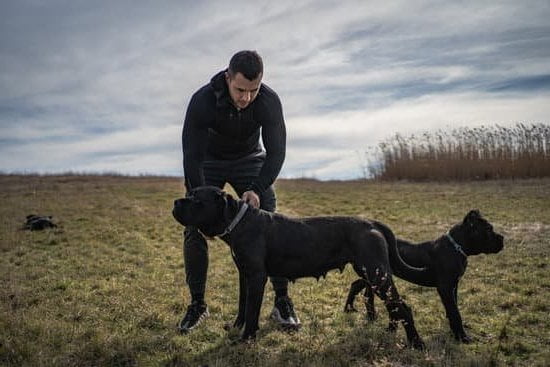Training a dog can be an incredibly fulfilling experience, but it requires the right tools and techniques to achieve success. One essential tool that every dog owner should have in their training arsenal is a training leash. In this article, we will explore the importance of using a training leash for optimal dog training results and discuss its benefits in promoting obedience and control.
A training leash serves as a crucial aid in teaching your dog proper behavior and commands. It provides you with the ability to guide and direct your furry friend effectively during training sessions. Using a leash allows for clear communication between you and your dog, enabling them to understand what is expected of them. With consistent use of a training leash, you can instill discipline and promote good behavior in your dog.
Furthermore, a training leash offers added safety measures by keeping your dog under control when outside or in unfamiliar environments. It prevents them from running off or getting into potentially dangerous situations. A well-fitted and properly adjusted leash minimizes the risk of accidents or conflicts with other dogs or pedestrians.
Throughout this article, we will delve into various aspects of using a training leash for effective dog training. We will discuss different types of leashes available, how to select the right one for your dog’s size and behavior, techniques for familiarizing your canine companion with the leash, as well as essential training methods that can be employed with the help of a leash.
By utilizing a training leash correctly, you can lay down the groundwork for more advanced off-leash activities while ensuring safety and control during the initial stages of obedience training. So let’s dive into this comprehensive guide on using a training leash for optimum results in all aspects of your dog’s education.
Understanding the Different Types of Training Leashes
When it comes to training leashes for dogs, there are various types available on the market. Each type has its own pros and cons, and it’s important to choose the right one based on your dog’s needs and training goals. Here, we will discuss the different types of training leashes, outlining their benefits and drawbacks.
1. Standard Leashes:
Standard leashes are the most common type of training leash used by dog owners. They typically range from 4 to 6 feet in length and come in different materials such as nylon or leather. These leashes provide a good amount of control and are suitable for basic obedience training.
They offer durability, ease of use, and can be found at a reasonable price point. However, it’s important to note that they do not provide much flexibility in terms of length.
2. Retractable Leashes:
Retractable leashes are popular among dog owners because they offer more freedom for dogs to explore while still maintaining control. These leashes have a spring-loaded mechanism that allows you to easily adjust the length of the leash as needed.
They typically extend up to 26 feet or more, giving dogs more room to roam. However, retractable leashes may not be suitable for all dogs as they can be difficult to handle if your dog tends to pull or if you need precise control in certain situations.
3. Long Lines:
Long lines are longer than standard leashes and provide even more freedom for dogs during training sessions while still maintaining some level of control. These leashes can range from 15 feet up to 50 feet or more, depending on your needs.
Long lines are particularly useful for recall training exercises where you want your dog to learn how to come back to you from a distance. However, they can be tricky to handle if not used properly and may require additional practice before using them effectively.
Before choosing a training leash, consider factors such as your dog’s size, breed, and behavior. Smaller dogs may do well with a standard leash, while larger dogs may benefit from a retractable or long line leash. It’s also important to select a leash that offers comfort, durability, and control. By understanding the different types of training leashes available and considering your dog’s specific needs, you can make an informed decision that will contribute to effective training.
Selecting the Right Training Leash for Your Dog
When it comes to selecting the right training leash for your dog, there are several important factors to consider. These factors include the size and breed of your dog, as well as their behavior during walks and training sessions. By choosing the appropriate training leash, you can ensure comfort, durability, and control during training sessions.
Firstly, consider the size of your dog when selecting a training leash. Smaller dogs may benefit from a lighter and shorter leash that allows for more control, while larger dogs may require a longer and sturdier leash for better handling. Additionally, considering the breed of your dog is important as certain breeds may have specific needs or preferences when it comes to leashes.
Another factor to consider is your dog’s behavior during walks and training. If your dog tends to pull or exhibit aggressive behavior while on a leash, you may want to opt for a harness-type leash that provides better control and prevents choking or discomfort. On the other hand, if your dog behaves well during walks and only requires light guidance, a standard leash may be sufficient.
Comfort is also an important aspect to consider when choosing a training leash for your dog. Look for leashes with padded handles or ergonomic designs that provide comfort and prevent chafing or wrist strain. Additionally, durability is crucial in ensuring that the leash lasts through numerous training sessions without breaking or fraying.
Familiarizing Your Dog with the Training Leash
One of the first steps in using a training leash for your dog is to familiarize them with wearing it. This process is crucial to ensure that your dog becomes comfortable with the leash and does not associate it with fear or discomfort. Here is a step-by-step guide on how to introduce the training leash to your dog:
- Start by choosing a lightweight and comfortable training leash that suits your dog’s size and breed. Avoid using heavy or bulky leashes as they may cause discomfort for your dog.
- Show the leash to your dog, allowing them to sniff and investigate it. Offer positive reinforcement, such as treats or praise, to create a positive association with the leash.
- Once your dog is calm and relaxed, gently slip the leash over their neck or attach it to their collar or harness. Be gentle and avoid pulling or tugging on the leash at this stage.
- Let your dog walk around with the leash on for short periods of time indoors. Monitor their behavior and provide positive reinforcement whenever they exhibit calm and relaxed behavior while wearing the leash.
- Gradually increase the duration of time your dog spends wearing the leash indoors before moving on to outdoor environments. Take them outside while wearing the leash but avoid any sudden movements that may startle them.
- As your dog becomes more accustomed to wearing the training leash, incorporate short walks and basic obedience commands into their routine while on-leash. Continue praising and rewarding them for good behavior during these sessions.
It is important to remember that each dog may have varying degrees of comfort when it comes to wearing a training leash, so be patient throughout this process. If you encounter any resistance or reluctance from your dog, take a step back and give them more time to adjust before progressing further.
| Benefits | Tips |
|---|---|
| – Promotes safety and control during training | – Choose a lightweight and comfortable leash |
| – Allows for better communication between owner and dog | – Use positive reinforcement to create a positive association with the leash |
| – Helps to establish boundaries and reinforce obedience | – Start indoors and gradually transition to outdoor environments |
Properly Fitting and Adjusting the Training Leash
One of the key aspects of using a training leash effectively is ensuring that it is properly fitted and adjusted for your dog. A poorly fitting leash can not only compromise your control over the dog but also pose a safety risk. It is essential to take the time to find the right fit for your dog’s size, breed, and behavior.
To begin, you should consider the material and design of the training leash. There are different materials available, such as nylon, leather, or chain leashes. It is important to choose a leash that offers comfort for your dog while still providing durability and control during training sessions. Additionally, consider factors like handle grip and ease of use when making your selection.
Next, you should focus on finding the proper length for the leash. The length will depend on both your training goals and the environment in which you’ll be training. For instance, if you’re practicing basic obedience commands in a confined space, a shorter leash may be more suitable. On the other hand, if you’re working on recall commands in an open area, a longer leash may provide more freedom for your dog’s movement.
Once you have selected a leash that meets these criteria – suitable material and design as well as appropriate length – it is important to adjust it correctly for your dog’s comfort and safety. Ensure that there are no knots or tangles along the length of the leash to prevent any discomfort or accidents. Check that there is enough slack for your dog to move comfortably but not too much so they won’t wander off or become tangled.
Remember that correct fitting and adjustment play a significant role in maintaining control when using a training leash. Regularly check that the leash is still properly fitted as dogs may grow or change their behavior over time. By consistently ensuring that your dog has a properly fitted and adjusted training leash, you can maximize its effectiveness in promoting obedience and control during training sessions.
Essential Training Techniques with the Training Leash
Basic Obedience Commands
One of the primary purposes of using a training leash is to teach your dog basic obedience commands. These commands, such as sit, stay, and come, are essential for maintaining control and ensuring the safety of your dog in various situations. With the use of a training leash, you can effectively communicate your expectations to your dog and reinforce good behavior.
To start, attach the leash to your dog’s collar or harness and hold it firmly but loosely in your hand. Begin with simple commands like “sit” by gently pulling up on the leash while giving the corresponding verbal command. As soon as your dog complies and sits down, reward them with praise or a treat. Repeat this process several times until your dog learns to associate the action of sitting with the command.
Similarly, you can use the training leash for commands like “stay” and “come.” When teaching the “stay” command, step away from your dog while holding onto the leash. If they attempt to follow you, gently pull back on the leash to remind them to stay in place. Gradually increase the distance and duration of their stays as they become more comfortable.
For teaching “come,” start by walking a few steps away from your dog while holding onto the leash. Say their name followed by “come.” Gently guide them towards you by using small tugs on the leash if necessary. As they approach you, reward them with praise or a treat. Practice these commands regularly with consistency to reinforce positive behavior.
Addressing Behavioral Issues
In addition to basic obedience commands, a training leash can be instrumental in addressing common behavioral issues such as pulling on walks, jumping on people, and excessive barking. With proper techniques and patience, these behaviors can be effectively corrected with consistent use of a training leash.
When addressing pulling on walks, it’s important not to yank or jerk the leash, as this can cause discomfort or injury to your dog. Instead, use gentle but firm pressure on the leash when your dog starts pulling. As soon as they respond by walking loosely by your side, reward them with praise and continue walking. With consistent training, your dog will learn that pulling on the leash is not rewarded and will gradually stop the behavior.
For jumping on people, utilize the training leash to maintain control and prevent your dog from jumping up. When your dog tries to jump, step on the leash with one foot or quickly pull upwards to redirect their attention. Simultaneously give a verbal command like “off” or “down” and reward them for complying. Consistency is key in teaching your dog that jumping is an unwanted behavior.
Excessive barking can also be addressed with the use of a training leash. Firmly but gently hold onto the leash when your dog starts barking excessively. Give a command like “quiet” or “enough” in a calm and assertive tone. If they continue barking, apply slight pressure on the leash to interrupt their behavior. Once they are quiet, reward them with praise or a treat. Repeat this process consistently whenever excessive barking occurs.
By using these essential training techniques with a training leash, you can effectively teach your dog basic obedience commands and address behavioral issues in a positive and controlled manner. Remember to remain patient, consistent, and always reward good behavior to ensure optimal training results.
Common Mistakes to Avoid When Using a Training Leash
Holding the Leash Incorrectly
One common mistake that dog owners make when using a training leash is holding it incorrectly. It is important to hold the leash with a firm but relaxed grip. Avoid gripping the leash too tightly, as this can create tension and anxiety in your dog, leading to resistance or pulling. Conversely, holding the leash too loosely can result in a lack of control and allows your dog to wander off or become easily distracted.
A good technique is to wrap the training leash around your hand once or twice, creating a loop that fits snugly on your wrist or hand. This helps to lessen strain on your hand and provides better control over your dog’s movements. Always ensure that you have a secure grip on the leash, especially when walking in crowded areas or encountering potential distractions.
Inconsistent Use of Verbal Cues
Consistency is key in any form of dog training, and this includes using verbal cues alongside the training leash. Many owners unknowingly make the mistake of using different words or commands for the same action, confusing their dogs and hindering progress.
To avoid this mistake, establish a set of clear and consistent verbal cues for desired actions such as “sit,” “stay,” and “heel.” Use these cues consistently every time you give a command while also utilizing the training leash for guidance. Reinforce these verbal cues with positive reinforcement like treats or praise whenever your dog responds correctly.
Reacting Negatively to Mistakes
Another common mistake when using a training leash is reacting negatively to mistakes made by your dog during training sessions. It’s important to remember that dogs learn best through positive reinforcement rather than punishment.
If your dog makes a mistake or doesn’t respond as expected, avoid getting angry or scolding them harshly. Instead, calmly redirect their attention back to the desired behavior and provide positive reinforcement when they respond correctly. This encourages your dog to associate training with positive experiences and builds a stronger bond between you and your furry companion.
By avoiding these common mistakes, you can ensure a more effective and enjoyable training experience for both you and your dog. Remember, patience, consistency, and positive reinforcement are the keys to successful leash training. With time and practice, you will see progress as your dog becomes more obedient and well-behaved on the training leash.
Dos and Don’ts of Using a Training Leash
Using a training leash can be an effective tool for dog owners looking to train their pets. However, it is important to understand the dos and don’ts of using a training leash to ensure safe and effective training sessions. By following these guidelines, you can promote positive learning experiences for your dog while maintaining control and safety.
Dos
- Do start with a lightweight and comfortable leash: Choose a leash that is suitable for your dog’s size and breed. It should be lightweight, durable, and comfortable for both you and your pet.
- Do use the proper length of the leash: Adjust the length of the leash based on the specific training activity. For general obedience commands, use a short leash to maintain control. For behavior modification exercises, consider using a longer leash to give your dog more freedom to move.
- Do maintain consistent communication: Use clear and consistent verbal cues along with physical signals when using the training leash. This will help your dog understand what is expected of them during training sessions.
- Do reward good behavior: Positive reinforcement is key in any training program. When your dog behaves correctly while on the training leash, reward them with treats, praise, or playtime to reinforce their good behavior.
Don’ts
- Don’t use excessive force: Avoid pulling hard on the leash or jerking it abruptly as this can cause discomfort or injury to your pet. Instead, apply gentle pressure and release it once your dog responds appropriately.
- Don’t leave the leash unattended or attached to a stationary object: Always supervise your dog when they are wearing the training leash to prevent tangles or accidents. Additionally, avoid leaving them tethered with the leash attached to an object as this may result in injuries if they become tangled or try to escape.
- Don’t use the training leash as a form of punishment: The purpose of the training leash is to guide and enhance positive behavior, not to punish or instill fear in your dog. Avoid using the leash to yank or discipline your pet, as this can lead to negative associations with the training process.
- Don’t rush the training process: Patience and consistency are key when training with a leash. Avoid rushing through exercises or becoming frustrated if progress is slow. Each dog learns at their own pace, so give them ample time to understand and respond to your commands.
By following these dos and don’ts of using a training leash, you can create a positive and effective learning environment for your dog. Remember, consistency is crucial, so make sure to dedicate regular training sessions with your pet and celebrate their progress along the way.
Gradually Transitioning from a Training Leash to Off-Leash Training
Once your dog has mastered obedience with the training leash, you may be ready to start transitioning to off-leash training. This is an important step in your dog’s training journey and can give them more freedom while still maintaining control and reinforcing their previous training.
Before starting off-leash training, it is crucial to ensure that your dog has a strong foundation of obedience commands with the training leash. They should consistently respond to commands such as sit, stay, and come when on the leash. This will provide a solid base for off-leash work.
To begin the transition, find a secure and enclosed area where you can practice without distractions. Start by using a long-line leash or retractable leash that will still allow you some control if needed. Begin by giving your dog more freedom and gradually increase their distance from you while maintaining their focus on you and responding correctly to commands. Reward them with praise or treats for successful responses.
Over time, once your dog is consistently responding well with the longer leash, you can begin removing it completely in safe environments such as fenced yards or quiet parks. However, it is essential to continue practicing in controlled environments before challenging your dog in more distracting areas.
During off-leash training sessions, it’s important to stay vigilant and attentive to your dog’s behavior. Be prepared to step in quickly if they show signs of not obeying commands or getting too distracted by their surroundings. Using verbal cues combined with hand signals can also help reinforce commands when your dog is at a distance from you.
Remember that transitioning to off-leash training requires patience and consistency. It may take time for your dog to become comfortable with the increased freedom but continue to provide positive reinforcement for good behavior. With consistent practice and reinforcement techniques, your dog will gradually learn how to behave responsibly even without the physical restraint of a training leash.
Transitioning from a training leash to off-leash training is an important milestone for both you and your dog. It not only allows your dog more freedom but also demonstrates their progress in obedience and control. By following the gradual transition process and maintaining consistency in your training techniques, you can ensure a smooth and successful progression towards off-leash training.
Conclusion
In conclusion, using a training leash is essential for effective dog training. Throughout this article, we have discussed the different types of training leashes available and how to select the right one for your dog. We have also outlined techniques for introducing and fitting the leash correctly, as well as essential training methods and common mistakes to avoid.
However, it is important to remember that mastery in dog training can only be achieved through consistent training and positive reinforcement. No matter what type of leash you choose or the techniques you employ, success will come from dedicated practice and patience. Training a dog takes time, effort, and commitment.
It is crucial to celebrate small victories along the way and to never give up on your furry friend. Dogs thrive on positive reinforcement, so be sure to reward them for their progress. By consistently practicing obedience commands and addressing behavioral issues with the use of a training leash, you will gradually see improvement.
Remember that every dog is unique and may require individualized approaches in their training journey. If you encounter challenges or find that certain methods are not working for your dog, don’t hesitate to seek professional help from a reputable trainer or behaviorist.
By implementing proper leash training techniques and staying dedicated to your dog’s development, you can establish a strong bond with them built on trust, obedience, and mutual respect. With time and perseverance, both you and your canine companion will reap the rewards of a well-trained dog. So keep practicing, stay patient, and enjoy the journey towards mastery with your faithful companion by your side.
Frequently Asked Questions
How do I train my dog on a leash?
Training your dog on a leash requires consistency, patience, and positive reinforcement. Start by choosing the right type of leash and collar that suits your dog’s breed and size. Begin in a controlled environment without distractions, such as indoors or in your backyard. Introduce the leash gradually by allowing your dog to sniff and explore it before gently attaching it to their collar.
Slowly walk with your dog while holding the leash loosely and praising them for following alongside you. Reinforce good behavior with treats or verbal praise. Gradually increase the duration of walks and expose your dog to different environments, rewarding them for maintaining good leash manners. Consistency is key in reinforcing proper leash training habits.
How do I get my dog to stop pulling on the leash?
If your dog tends to pull on the leash, there are several techniques you can try to address this behavior. Firstly, ensure that you have a well-fitted harness or collar that minimizes discomfort while walking. Teach your dog basic obedience commands like “sit” or “stay,” which can also be useful during walks when they begin pulling.
When your dog starts pulling, stop walking immediately and wait for them to come back towards you or release tension on the leash. Once they do, reward them with praise or a treat before continuing the walk again. Another effective technique is changing direction abruptly when your dog pulls, which encourages them to focus on staying close rather than dragging ahead.
How long does it take to leash train a dog?
The time it takes to leash train a dog can vary depending on various factors such as age, breed, temperament, and previous experiences with leashes or walking equipment. While some dogs may quickly grasp proper leash manners within weeks, others may take several months to fully adapt to walking on a leash without pulling or displaying unwanted behaviors. Consistency and dedication play an essential role in facilitating quick progress during training sessions.
Regular practice sessions coupled with positive reinforcement techniques can help speed up the process of training dogs on a leash successfully. However, it’s important to remember that each dog is unique, and training timelines can vary.

Welcome to the blog! I am a professional dog trainer and have been working with dogs for many years. In this blog, I will be discussing various topics related to dog training, including tips, tricks, and advice. I hope you find this information helpful and informative. Thanks for reading!





